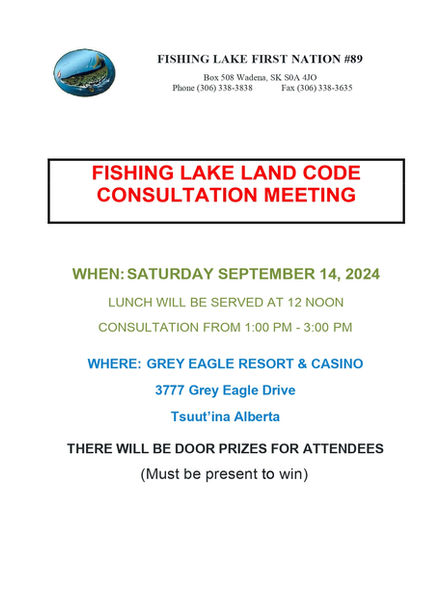
Land Code Consultation Meetings
Updates
These are updates on what we are currently working on with the Land Code.

The Framework Agreement
The Framework Agreement on First Nation Land Management (Framework Agreement) is a government-to-government agreement that was initiated by 13 First Nations to opt out of the land management sections of the Indian Act. The Framework Agreement provides the option to govern reserve lands outside the confines of the Indian Act.
Purpose of the Framework Agreement
The Framework Agreement provides First Nations with all the legal status and powers needed to govern and The intent of the Framework Agreement is to recognize the governance authority of First Nations over their reserve lands, resources, and environment. The Framework Agreement not only includes administrative management responsibilities previously conducted by Canada as specified by the Indian Act, but also recognizes the ability of First Nations to make, administer and enforce law, manage their First Nation Land and natural resources.
A First Nation power includes:
-
all the rights, powers and privileges of an owner and;
-
the authority to grant interests or land rights and licenses in relation to its First Nation Land and;
-
to manage its natural resources
-
The Framework Agreement recognizes the First Nation inherent right to govern its own reserve lands and resources.
Phases of the Framework Agreement
There are 4 phases of the Framework Agreement Process.
1 - Entry Phase:
The first phase is the Entry Phase, where the First Nation becomes a signatory to the Framework Agreement. Chief and council became signatories on November 15th, 2022.
2 - Development Phase:
The second phase is the Development Phase, where a First Nation develops their land code and concludes an Individual Agreement with Canada. Fishing Lake First Nation is currently in this Phase.
3 - Ratification Phase:
The third phase is the Ratification Phase. During this phase, the First Nation engages the community to vote on the land code and Individual Agreement.
4 - Transitional/Operational Phase:
The final phase is the Transitional/Operation Phase, where the First Nation will now transition to land code implementation.
Benefits of the Framework Agreement to First Nations
There are a number of major benefits to First Nations who ratify and begin working under their Land Code, including:
-
Recognition of the inherent right to govern reserve lands and resources
-
Removal of reserve lands from the Indian Act
-
Participation of both on and off members in decision and law-making processes
-
Increased accountability to members of the First Nation
-
More efficient governance of First Nation land
-
Recognition of First Nation legal capacity to acquire and hold property, to borrow, to contract, to expend and invest money, to be a party to legal proceedings, to exercise its powers and to perform its duties
-
Direct control of land revenue previously held in trust by Canada
-
Recognition of the right to directly receive revenue from interests in First Nation land
-
Protection for First Nation land against arbitrary expropriation and loss through surrender for sale
-
Ability of a First Nation to pass environmental laws, and to develop environmental assessment and protection regimes
-
Recognition of significant law-making powers respecting First Nation land
-
Recognition in Canadian courts of First Nation laws
-
Removal of the need to obtain Ministerial approval for First Nation decisions
-
Recognition of right to create modern offences and enforcement for breach of First Nation laws
-
Ability to appoint Justices of the Peace
-
Ability to create local dispute resolution processes
-
Establishment of land registry regulations and an electronic land registry system
-
Establishment of a First Nation created and controlled Lands Advisory Board and Resource Centre to provide professional technical and political assistance to First Nations
-
Time saved in getting business done, operate at the speed of business
Land Code Resources
44 Sections of the Indian Act Replaced by a Land Code
Please look at the breakdown of the 44 sections of the Indian Act that will be replaced by the Land Code. Some sections include:
-
Section 18 - Minister no longer authorizes use of reserve lands for community purpose.
-
Section 53, 55, 56 - Minister no longer has authority to manage or sell surrendered land or lease designated lands.
You can view this by clicking the link below:
First Nations Land Governance: The Framework Agreement on First Nation Land Management
This brochure breaks down what a framework agreement is, how to become a signatory, differences between the framework agreement land governance and the Indian Act, what a Land Code is, where the Signatories are located, and much more.
You can view this by clicking the link below:
FLFN Reserve Status Land
These are the lands that will be identified to come under the Land Code:
-
Fishing Lake First Nation #89 Total Lands containing 4,537 hectares (11, 206 acres), more or less
-
Fishing Lake First Nation #89A Total Lands containing 254 hectares (627 acres) more or less
-
Sabitawasis Beach #89C-1 Total lands containing 60 hectares (148 acres) more or less
-
Fishing Lake First Nation #89D1 Total Lands containing 63 hectares, (155 acres) more or less
You can view them by clicking the links below:
Draft of FLFN Land Code
This is the first draft of the Land Code for FLFN, please contact the land code coordinator if you have any suggestions regarding the draft and were unable to attend the consultation meetings.
The Land Code Coordinator's information is located under the "Contact Us" section.
You can view this by clicking the link below:
Committee Members

Brent Sunshine
Committee Chair
Jaylene Thunder
George Kayseas
Willard Young
Gary Desjarlais
Kimberly Kayseas
Darren Slippery
Darryl Slippery
Contact Us
© 2025 Fishing Lake First Nation













